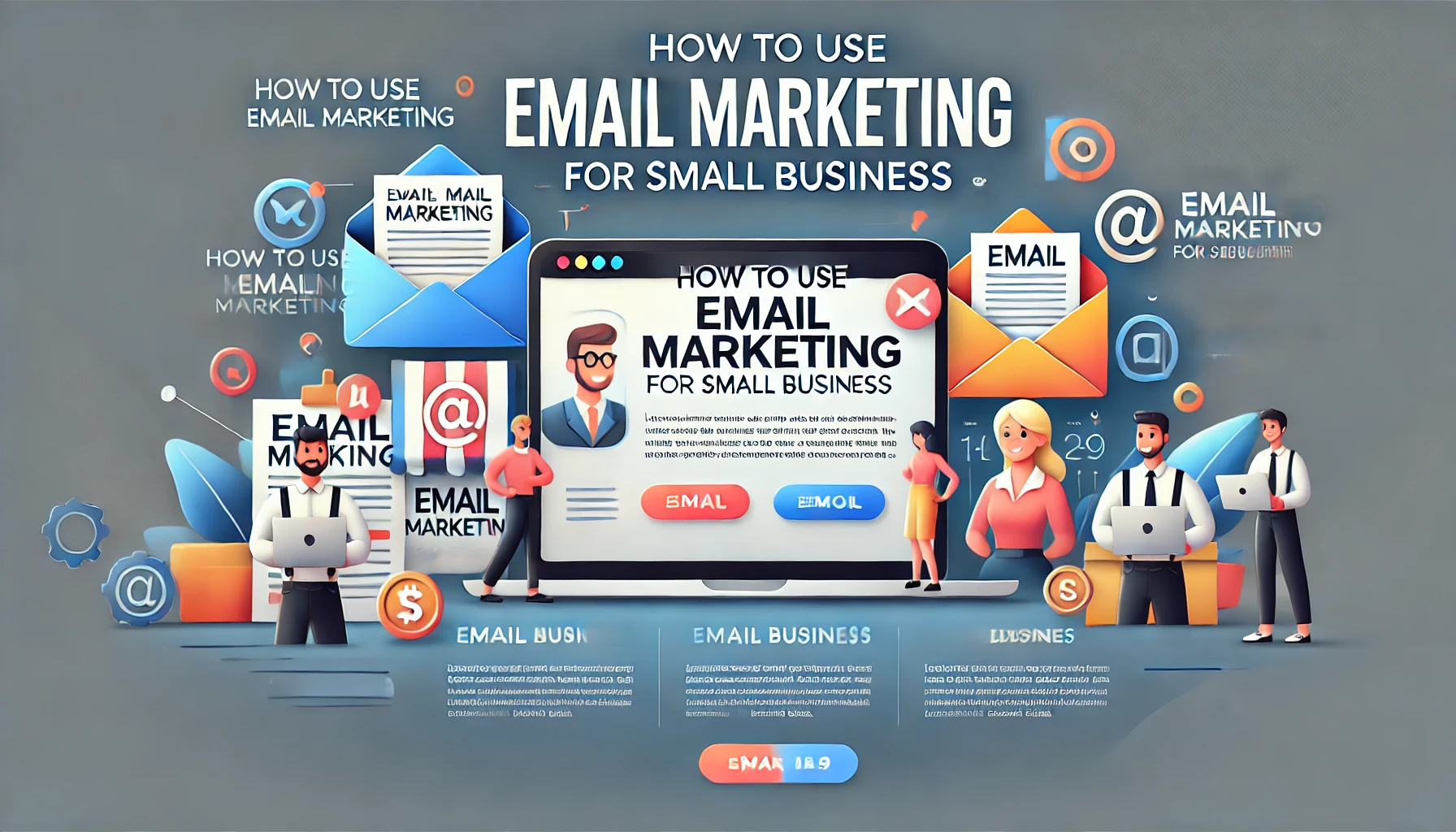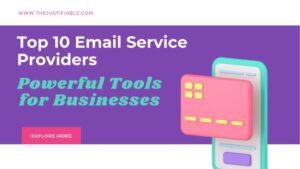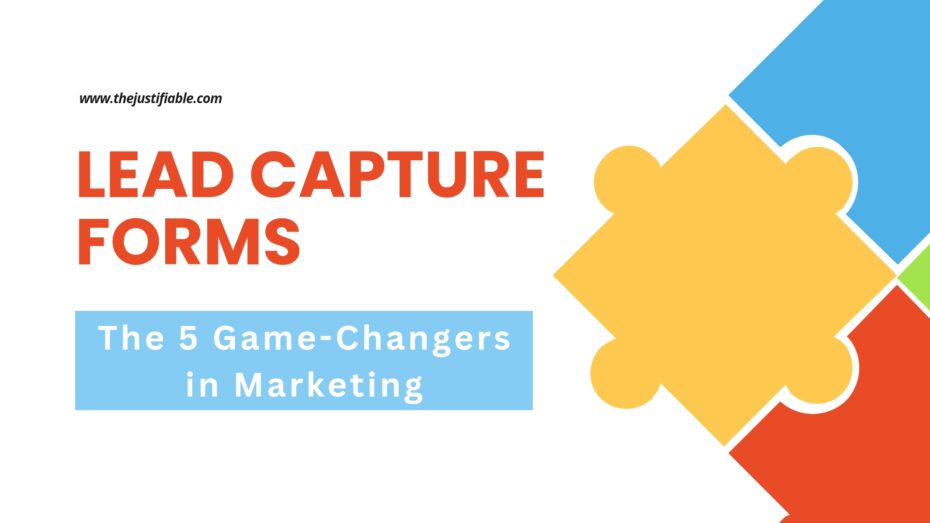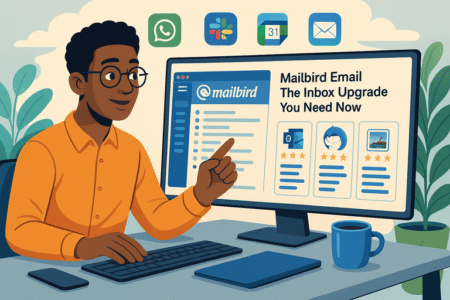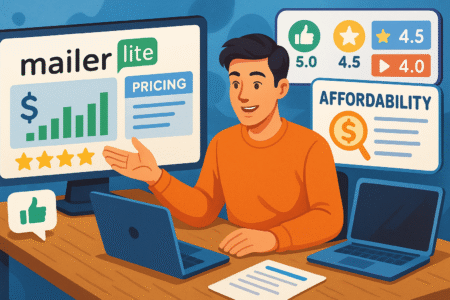Table of Contents
Are you a small business looking to leverage email marketing effectively? Wondering how to use email marketing for small business to reach new customers and drive growth?
This guide will walk you through actionable strategies and techniques for using email marketing to achieve your business goals.
Understanding Email Marketing Basics
Email marketing is a powerful tool for small businesses to connect with customers, promote products, and build loyalty. With the right approach, email marketing can become an effective strategy for driving growth and increasing brand visibility.
What Is Email Marketing For Small Business?
Email marketing for small businesses involves using targeted emails to engage potential and existing customers. It’s a way to build relationships, share news, and promote offers directly to people’s inboxes, driving attention to your products or services.
Through personalized emails, small businesses can communicate directly with customers, creating a sense of familiarity. This makes email marketing an ideal choice for maintaining consistent engagement. Whether sharing updates or promotions, email helps businesses stay connected in a meaningful way.
When done correctly, email marketing fosters trust between a business and its audience. It provides a non-intrusive platform where customers can engage at their convenience, strengthening customer loyalty over time.
I believe email marketing is an essential tool for small businesses that want a cost-effective, efficient way to communicate directly with their audience. It’s scalable and can grow alongside your business’s needs.
Benefits Of Email Marketing For Small Businesses
One major benefit of email marketing for small businesses is its affordability. Unlike other channels, email marketing allows businesses to reach a broad audience without breaking the bank. It’s budget-friendly, which is ideal for small enterprises.
With email marketing, you can personalize messages based on customer preferences. This tailored approach increases engagement by making customers feel valued. Personalized emails can lead to higher open rates, clicks, and conversions, making them highly effective.
Email marketing also offers measurable results. Metrics like open rates, click-throughs, and conversions provide insights into campaign performance. This data helps small businesses fine-tune their strategies for better outcomes.
Regular emails keep your brand top of mind. By staying present in customers’ inboxes, small businesses can build brand awareness and maintain engagement. This sustained connection can drive repeat business and brand loyalty.
How Email Marketing Works: Key Components
Successful email marketing has essential components: a targeted email list, quality content, and a clear call-to-action. First, building a relevant email list ensures messages reach the right audience. I suggest focusing on quality over quantity here.
Quality content is crucial. Emails should be engaging, informative, and aligned with your brand. Whether promotional or informational, content needs to resonate with your audience and provide real value to encourage interaction.
Calls-to-action are vital for guiding recipients on what to do next. Clear, action-oriented prompts encourage readers to take steps like purchasing, signing up, or learning more, enhancing your emails’ effectiveness.
Tracking and analyzing performance is key. By monitoring metrics, small businesses can identify what works, adjust strategies, and improve results over time. This makes email marketing a dynamic tool for growing your business.
Common Email Marketing Terms Small Businesses Should Know
Knowing common email marketing terms can help small businesses navigate campaigns confidently. Terms like “open rate” indicate how many recipients opened an email, a key metric for gauging interest and engagement.
“Click-through rate” (CTR) measures how many clicked on links within an email. A high CTR shows that your content and call-to-actions resonate well with recipients, prompting them to explore further.
“Bounce rate” refers to undeliverable emails that didn’t reach the inbox. High bounce rates can impact sender reputation, so keeping your email list clean and up-to-date is essential for successful campaigns.
Lastly, “conversion rate” reflects the percentage of recipients who completed a desired action after opening an email. Monitoring conversions provides insights into campaign effectiveness, helping you adjust strategies for better performance.
Building An Email List From Scratch
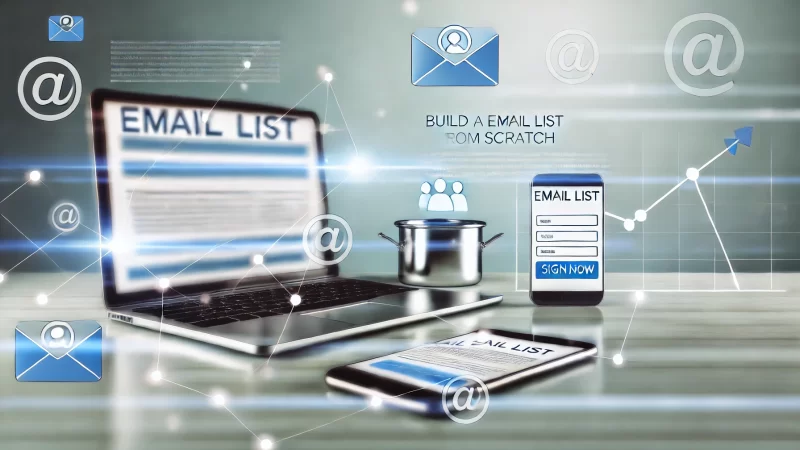
Building an email list is a vital first step in email marketing for small businesses. A quality list ensures your messages reach an interested audience, setting the foundation for successful campaigns that drive engagement and growth.
Proven Strategies For Growing An Email List
Offering incentives, like discounts or free resources, is an effective way to attract subscribers. People are more likely to sign up when they receive immediate value, such as a welcome offer or an exclusive download in exchange for their email.
Social media is another powerful tool for list building. By promoting your newsletter on platforms like Facebook or Instagram, you can reach a wider audience. I recommend creating a dedicated sign-up link that followers can easily access.
Hosting webinars or events can also help build your list. These events provide valuable content and a chance to engage with your brand. Encourage attendees to sign up for updates or exclusive offers to stay connected.
Collaborations with other brands can introduce your business to new audiences. Cross-promotions allow you to tap into an existing customer base, helping grow your list while building brand credibility.
Opt-In Forms: Tips To Attract Subscribers
Placing opt-in forms in high-visibility areas on your website, like the homepage or blog posts, can increase sign-ups. Forms should be simple, with a clear call-to-action, encouraging visitors to subscribe with minimal effort.
Consider using pop-up forms strategically. While pop-ups can be effective, they should not be disruptive. I suggest timing them to appear after a visitor has spent time on the page, making them less intrusive but still attention-grabbing.
Mobile-friendly forms are essential. Many users will visit your site on mobile devices, so ensure opt-in forms look good and function well on all screen sizes, helping capture leads from any platform.
Personalized opt-ins can boost sign-ups by aligning with user interests. Using specific messages, like “Sign up for travel deals” or “Get marketing tips,” tailors the experience and makes your offer more compelling.
Lead Magnets: How To Boost Small Business Sign-Ups
Lead magnets are incentives offered in exchange for email addresses, making them an effective list-building tool. A popular lead magnet, such as an ebook, provides value and attracts interested subscribers who are likely to engage.
Discount codes work well for small businesses looking to drive initial sales. Offering a discount for new subscribers is a powerful motivator that benefits both the customer and your brand, encouraging conversions.
Free trials or samples appeal to potential customers who want to experience your product. I advise this for businesses with digital products or services, as it can help convert subscribers into loyal customers over time.
Exclusive content, like webinars or industry insights, is another valuable lead magnet. It positions your business as an authority in your field, drawing in subscribers who are genuinely interested in what you offer.
GDPR And CAN-SPAM Compliance For Small Businesses
Complying with GDPR and CAN-SPAM regulations protects both your business and customers. These laws require businesses to get consent before sending marketing emails, ensuring subscribers only receive content they opted into.
GDPR requires transparency in how you collect and use data. Small businesses must clearly state how subscriber data is stored and used. Adding a privacy notice at the sign-up point fulfills this requirement and builds trust.
CAN-SPAM regulations protect users from spam emails. Ensuring an easy unsubscribe option and accurate sender information helps maintain compliance. I believe respecting subscribers’ choices improves brand credibility.
Regularly updating your email list is essential. Remove inactive subscribers and monitor for any complaints. Staying compliant not only protects your business legally but also fosters trust with your audience, which is key for long-term success.
Crafting Engaging Email Content
Creating engaging email content is essential for small business success. By writing compelling messages that resonate with your audience, you can improve open rates, increase clicks, and strengthen relationships with your subscribers.
Writing Emails That Capture Attention
To capture attention, start emails with a strong subject line. I suggest focusing on benefits or curiosity-inducing phrases to make readers eager to open. Aim to be direct yet intriguing, showing immediate value to your audience.
Opening sentences should pull readers in by addressing their needs or desires. A personal approach, such as asking a question or acknowledging their interests, creates a friendly, inviting tone that encourages further reading.
Keep emails concise and valuable. Readers appreciate brevity, so focus on delivering the main message quickly. Highlight key points clearly, and make sure the content is easy to scan for readers who are short on time.
Always close with a clear call-to-action. Whether you want readers to visit your site, shop a sale, or learn more, a direct prompt guides them toward the next step, ensuring your message achieves its purpose.
Power Words To Use In Small Business Emails
Power words evoke emotion and create urgency, making emails more engaging. Words like “exclusive,” “guaranteed,” and “limited” work wonders. I recommend using these sparingly to enhance key parts of the email without sounding overly promotional.
Incorporating positive language builds excitement. Words like “transform,” “amazing,” and “unbeatable” can make products or offers sound appealing. Such language taps into readers’ desires and keeps them interested in your message.
Using numbers can boost readability and impact. For instance, “Save 25% today” or “5 quick tips” creates a concrete sense of value. Numbers break up the text, making it more digestible and visually engaging.
Lastly, emphasize benefits over features. Readers care about how your product or service will improve their lives. Words like “simplify,” “enjoy,” and “achieve” focus on outcomes, helping readers visualize benefits and increasing engagement.
Structuring Emails For Higher Readability
A clean, organized structure makes emails inviting to read. Use short paragraphs and bullet points to enhance readability, helping subscribers easily absorb information without feeling overwhelmed by dense text blocks.
White space is your friend. By spacing out sections, you give readers’ eyes room to rest. I believe well-spaced emails feel lighter and more approachable, which can improve overall engagement with the content.
Headers and subheaders guide readers through the email. Clear headings allow readers to skim and find information quickly. I recommend using bold, attention-grabbing headers for important sections to keep the layout visually appealing.
Conclude with a strong call-to-action. Position it where it’s easily seen, encouraging readers to click. By placing a CTA in a prominent spot, you enhance the likelihood of conversions, making the email more effective.
Personalization Techniques For Small Business Success
Personalizing emails creates a connection with readers. I suggest using first names and tailoring content based on past interactions to make subscribers feel recognized and valued. This small touch can significantly boost engagement.
Segmenting your email list is essential for personalization. By dividing subscribers into groups based on preferences or purchase history, you can deliver relevant content that resonates, making the communication more meaningful.
Behavior-triggered emails perform well. For example, sending follow-ups after a purchase or interest-based recommendations keeps the communication relevant. Triggered emails show readers you understand their needs, enhancing loyalty.
Personalized recommendations add value. Showcasing related products based on previous actions can encourage repeat purchases. It’s a simple yet effective way to keep your business top of mind and increase customer satisfaction.
Types Of Email Campaigns For Small Businesses
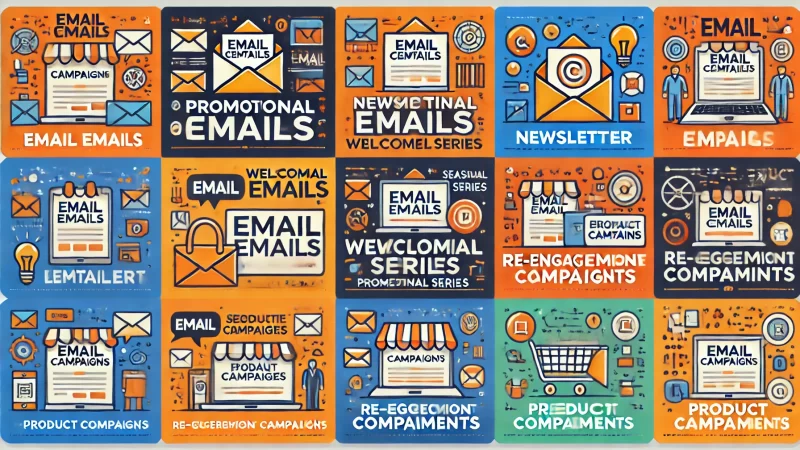
Small businesses can use various email campaign types to engage their audience. Each campaign serves a unique purpose, allowing you to connect with customers at different stages of their journey.
Welcome Series: Making A Strong First Impression
A welcome series introduces new subscribers to your brand. I recommend including a friendly, engaging message that thanks them for joining and provides a brief overview of what they can expect from your emails.
Incorporate a special offer or resource in the welcome email. This creates an incentive for subscribers to explore further, helping establish an immediate, positive connection that encourages continued engagement.
Share your brand story to foster connection. Giving new subscribers insight into your mission or values helps humanize your brand, making them feel more invested and likely to stay engaged with future emails.
Guide readers toward helpful resources. Links to popular blog posts, how-to guides, or product pages can enrich their experience, helping them get more out of their subscription and increasing the likelihood of brand loyalty.
Promotional Campaigns: Tips For Converting Subscribers
Promotional campaigns focus on driving sales and conversions. I suggest highlighting a strong, clear offer upfront, such as a discount or limited-time deal, to capture attention and encourage immediate action.
Use urgency to motivate purchases. Phrases like “only 24 hours left” can create a sense of urgency. However, use this technique sparingly to avoid overwhelming readers or making them skeptical of future promotions.
Visuals are crucial in promotional emails. Images of featured products or discounts make the email visually appealing and help convey the offer quickly. I believe well-placed visuals can significantly increase click-through rates.
Clear CTAs drive conversions. Make sure each promotional email has a noticeable, action-oriented button like “Shop Now” or “Grab The Deal,” making it easy for readers to take the next step directly from the email.
Nurture Campaigns: Building Long-Term Relationships
Nurture campaigns aim to deepen the relationship with your audience. Start with valuable content, such as helpful tips or informative articles, showing that your business prioritizes providing value beyond just sales.
Highlight customer stories or testimonials to build trust. By sharing experiences from other customers, you create social proof, making new subscribers feel more comfortable and engaged with your brand over time.
Send educational content that addresses subscribers’ needs. Sharing insights or industry knowledge helps position your business as an expert, which builds credibility and enhances trust in your products or services.
Regularly check in with your audience. Simple “thank you” messages or updates keep communication open without a hard sell. These touchpoints make subscribers feel valued, fostering a long-lasting relationship with your brand.
Seasonal And Event-Based Emails For Small Business Growth
Seasonal emails align your brand with current events, like holidays or local festivals, creating timely, relevant messages. These emails can help small businesses increase engagement by connecting with subscribers’ seasonal interests.
Customize offers based on the event. For example, a “back-to-school” sale or holiday gift guide appeals to subscribers looking for specific solutions, making it more likely they’ll engage with your promotion.
Incorporate a festive design to enhance visual appeal. Seasonal graphics, such as holiday-themed images or colors, make emails stand out and feel relevant, increasing the chances of readers opening and clicking through.
Plan ahead for event-based campaigns. Sending these emails at the right time, like weeks before a holiday, ensures subscribers have enough time to act on your offers, making the campaign more effective in driving results.
Optimizing Your Email Marketing Strategy
Optimizing your email marketing strategy is essential for maximizing engagement and achieving your small business goals. From testing content to analyzing performance, these steps help refine your approach and ensure your emails are effective.
A/B Testing Emails For Better Performance
A/B testing allows you to experiment with different email elements. I suggest testing subject lines, call-to-actions, or images to identify what resonates best with your audience, helping improve overall performance and engagement with each email sent.
Start small with subject lines. Testing a short, attention-grabbing line against a more detailed one can reveal which style your subscribers prefer. This can help you refine future subject lines for better open rates.
Experiment with different CTA placements. A/B testing the location of your call-to-action—like at the top or bottom of the email—can show which placement drives more clicks, guiding where to position your CTA in future emails.
Evaluate content formats. Test text-heavy content against visually-rich formats to understand what keeps your audience engaged. This insight helps tailor content to your readers’ preferences, improving their overall experience with your emails.
How To Track Key Email Marketing Metrics
Tracking key metrics is essential to understanding email performance. Metrics like open rate, click-through rate, and bounce rate reveal how effective your email marketing strategy is, helping you make data-driven adjustments for improvement.
Open rates show how many people opened your email, indicating subject line effectiveness. A low open rate suggests a need for more engaging subject lines to capture attention, making it an important metric to monitor regularly.
Click-through rates (CTR) track how many readers clicked links within your email. CTR reflects the appeal of your content and call-to-actions, helping you gauge how well your message resonates with subscribers.
Bounce rates indicate emails that failed to reach inboxes, affecting your sender reputation. Regularly checking your bounce rate ensures your email list remains healthy and optimizes deliverability to maximize the number of recipients.
Conversion rates measure the percentage of recipients who took the desired action, such as purchasing or signing up. Tracking this helps assess campaign success and fine-tune future strategies to drive more meaningful interactions.
Using Customer Feedback To Improve Campaigns
Customer feedback is invaluable for enhancing email campaigns. By gathering insights directly from your audience, you can refine your approach and deliver content that better aligns with their expectations and interests.
Surveys offer a simple way to understand subscriber preferences. Asking readers about topics they’d like to see or email frequency helps shape future campaigns, creating a more personalized experience that boosts engagement.
Monitor replies to your emails. Direct responses often contain insights about what readers find useful or what needs improvement, making this feedback a valuable resource for continuous optimization.
Customer reviews and testimonials can guide content creation. Highlighting positive feedback from actual users can boost credibility and show that you’re listening to and valuing customer experiences, which can increase loyalty.
Feedback on design and readability helps ensure emails are visually appealing. Readers may provide suggestions on layout or formatting that enhance readability, making your emails more enjoyable and accessible to all subscribers.
Analyzing And Improving Open And Click-Through Rates
Improving open and click-through rates is key to email marketing success. I suggest focusing on compelling subject lines, relevant content, and well-placed CTAs to encourage more interaction with each email you send.
Creating curiosity in your subject lines can significantly impact open rates. A question or interesting statement can make readers want to know more, drawing them into the email to learn what’s inside.
Personalization in content improves click-through rates. Addressing readers by name and tailoring content to their preferences shows a more personal touch, increasing the likelihood they’ll engage with your email.
Segmenting your list boosts relevance. By sending targeted emails to specific groups, you ensure content aligns with readers’ interests, which enhances both open and click-through rates by making emails more meaningful.
Placing a strong, clear CTA in each email guides action. A prominent CTA helps readers easily identify the next step, driving more clicks and achieving higher engagement with your marketing messages.
Automation Tools For Small Business Email Marketing

Automation tools streamline email marketing for small businesses, making it easier to maintain consistent communication with subscribers. With the right tools, you can automate repetitive tasks, increase efficiency, and improve engagement.
Essential Email Marketing Tools For Small Businesses
Effective email marketing tools offer features like list management, automation, and analytics. I recommend tools like Aweber, Moosend, and Omnisend that provide easy-to-use interfaces designed for small business needs and budgets.
Choose a tool with strong segmentation capabilities. Tools that allow you to divide your list based on customer behavior or interests make it easier to send targeted emails, enhancing relevance and engagement.
Look for automation features to save time. Automated workflows can manage welcome emails, abandoned cart reminders, and more, keeping your marketing consistent while allowing you to focus on other business tasks.
Analytics integration is a must. Tools that provide metrics on open rates, CTRs, and conversions enable you to assess campaign performance and make informed adjustments for continuous improvement.
Setting Up Automated Workflows For Consistency
Automated workflows ensure consistent engagement with subscribers. Setting up workflows for key touchpoints, like welcoming new subscribers, can help build connections and maintain ongoing communication without added effort.
Create a welcome workflow for new subscribers. Sending a series of emails introducing your brand and products helps new readers feel connected from the start, making them more likely to stay engaged with future emails.
Set up workflows for purchase confirmations or thank-you emails. These workflows acknowledge customer actions and enhance their experience, fostering positive relationships and increasing the likelihood of repeat purchases.
Birthday or anniversary workflows add a personal touch. Recognizing special occasions with an exclusive offer or message shows appreciation, adding a personalized element that makes subscribers feel valued.
Re-engagement workflows can win back inactive subscribers. A gentle reminder or exclusive offer for those who haven’t interacted recently can rekindle interest and encourage them to engage with your brand again.
Automating Follow-Up Emails To Boost Engagement
Automated follow-up emails keep subscribers engaged after specific interactions, like browsing or purchasing. I suggest setting up triggers based on these actions to send timely follow-ups that maintain interest and encourage further involvement.
Set up post-purchase follow-ups to thank customers and recommend related products. This enhances the customer experience and can lead to additional sales, as customers feel valued and guided in exploring more of what you offer.
Send cart abandonment emails to recover potential sales. Reminding customers of items left in their cart can prompt them to return and complete the purchase, helping reduce abandoned cart rates and increase revenue.
Follow up after content downloads or resource requests. A quick email asking if they found it helpful or offering related content keeps readers engaged, showing you care about their experience and want to provide continued value.
Engage subscribers after events or webinars with additional resources. This follow-up can include key takeaways or a special offer, keeping the interaction going and enhancing the value they gain from your brand.
Best Practices For Using Email Automation
Following best practices ensures automation supports engagement without overwhelming subscribers. Balancing frequency, personalization, and value helps create a positive experience that fosters long-term loyalty.
Avoid overloading subscribers with too many automated emails. Spacing out communications prevents email fatigue, ensuring subscribers stay interested and don’t feel overwhelmed by a constant stream of messages.
Personalize automated emails with subscriber details. Including names, past purchases, or browsing history in automated messages makes the content feel relevant and engaging, increasing the likelihood of interaction.
Keep the content valuable. Even automated emails should provide something meaningful, whether it’s a helpful tip, special offer, or exclusive update. This approach keeps your audience engaged and eager for future emails.
Regularly review and update automation workflows. Checking performance metrics and making adjustments ensures your automated messages remain effective, aligning with changing subscriber preferences and optimizing engagement.
Avoiding Common Email Marketing Mistakes
Avoiding common email marketing mistakes is essential for maintaining a positive reputation and fostering meaningful engagement. Understanding these pitfalls can help small businesses build trust, increase deliverability, and improve overall campaign effectiveness.
Avoiding Spam Traps And Low Deliverability Issues
Avoiding spam traps protects your sender reputation. I suggest using only verified opt-in lists, as purchasing lists often leads to hitting spam traps, reducing deliverability and potentially blacklisting your domain from reaching inboxes.
Maintaining a clean email list is key. Regularly remove inactive subscribers and those who haven’t engaged in months. This improves list quality, ensuring your messages reach those who want them, boosting your deliverability rates.
Focus on proper authentication. Email authentication, like SPF, DKIM, and DMARC, verifies your emails, reassuring ISPs of their legitimacy. This practice builds trust with email providers, helping you avoid spam folders.
Engage subscribers to improve deliverability. Encouraging replies, interactions, and clicks signals to email providers that your emails are valuable. High engagement rates positively impact deliverability, ensuring more emails land in inboxes.
Overcoming Subscriber Fatigue And Unsubscribes
Overcoming subscriber fatigue requires balanced messaging. I recommend monitoring email frequency, as over-sending can overwhelm subscribers and lead to higher unsubscribe rates, while a consistent schedule maintains engagement without causing fatigue.
Segmenting your list can reduce fatigue. By sending relevant content to specific groups, you ensure subscribers receive messages they’re interested in, decreasing the likelihood of fatigue and boosting engagement.
Introduce preference centers. Offering subscribers options for content type and frequency allows them to tailor their experience. This approach reduces unsubscribes by giving readers control over what they receive from you.
Listen to subscriber feedback. Pay attention to unsubscribe reasons and complaints. This feedback can provide valuable insights into what’s working and what’s not, allowing you to adjust your approach and better meet subscriber expectations.
Managing Email Frequency Without Overwhelming Subscribers
Balancing email frequency helps avoid overwhelming subscribers. I suggest starting with a weekly or bi-weekly cadence, adjusting based on engagement. Consistent communication maintains interest without flooding inboxes, keeping subscribers engaged and interested.
Monitor open rates to gauge the ideal frequency. A drop in open rates might indicate over-sending, while stable or increasing rates suggest the frequency is working well for your audience.
Provide value in each email. Ensuring every message offers something worthwhile—like a tip, update, or exclusive offer—makes subscribers look forward to your emails, even if they’re frequent, reducing the risk of email fatigue.
Survey your audience about preferences. Asking subscribers how often they’d like to hear from you builds trust and helps maintain a communication rate that suits them, reducing the risk of disengagement from overwhelming emails.
Avoiding Overly Promotional Content: Finding A Balance
Avoiding overly promotional content is key to keeping subscribers engaged. I advise mixing promotional emails with educational or entertaining content to create a balance that resonates with readers and adds value beyond sales pitches.
Offer helpful insights related to your industry. Content like how-tos or tips provides value without pushing products directly, building trust and positioning your brand as a source of useful information for subscribers.
Highlight customer stories and testimonials. Sharing success stories subtly promotes your brand while offering social proof. This approach showcases benefits through real experiences, keeping emails engaging without being overly sales-focused.
Create a sense of community. Sharing updates, behind-the-scenes stories, or industry news builds connection and fosters loyalty. Subscribers appreciate feeling part of something meaningful, making them more receptive to occasional promotions.
Measuring Email Marketing ROI For Small Businesses
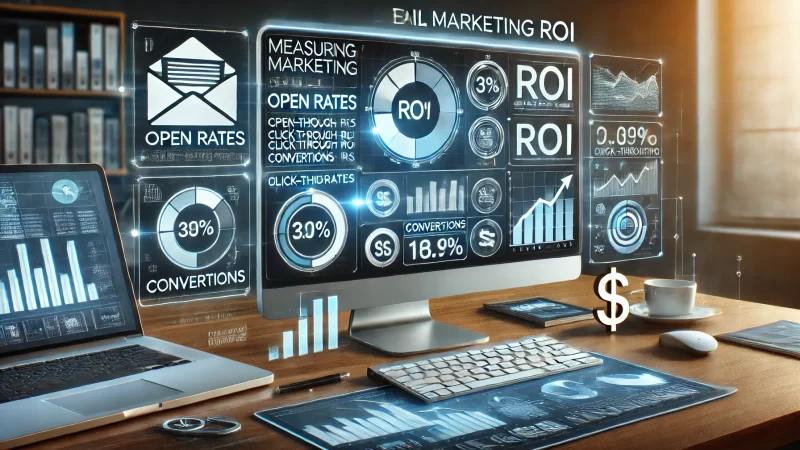
Measuring ROI in email marketing allows small businesses to assess the effectiveness of their campaigns. Tracking key metrics reveals which strategies work best, enabling data-driven improvements that optimize engagement and revenue.
Calculating The ROI Of Email Campaigns
Calculating ROI begins with understanding campaign costs and returns. I suggest totaling expenses—like platform fees, design costs, or discounts—and comparing them to revenue generated to see if campaigns are profitable.
Track sales from email links. Using unique URLs in your emails helps track purchases directly from your campaigns, providing concrete revenue data for accurate ROI calculation and helping you assess email effectiveness.
Consider non-monetary metrics, like brand awareness. While ROI usually focuses on revenue, metrics like increased website traffic or social shares can also indicate success, giving a fuller picture of campaign impact.
Evaluate overall growth trends. ROI isn’t always immediate; sometimes, it’s reflected in long-term growth. Watching trends over time can show whether email marketing contributes to gradual business expansion and customer loyalty.
Key Metrics To Measure Email Marketing Success
Tracking metrics like open rate, click-through rate (CTR), and conversion rate provides insights into campaign effectiveness. Each metric reveals different aspects of subscriber engagement, helping refine strategies for better results.
Open rates reflect subject line effectiveness. High open rates indicate that your subject lines are engaging and relevant, encouraging readers to explore further. I suggest testing various approaches to see what resonates best.
CTR measures interaction within the email. A high CTR shows that your content and CTAs are engaging, signaling interest in the information you provide, and helping gauge the email’s ability to drive action.
Conversion rates indicate goal completion. Whether sales, sign-ups, or downloads, tracking conversions shows whether your email achieved its objective, helping you assess what works and refine future campaigns.
Unsubscribe rates highlight content satisfaction. An increase in unsubscribes could suggest the need for content adjustments, helping you better meet reader expectations and maintain a positive subscriber experience.
Tools To Help Small Businesses Track ROI
Several tools offer comprehensive tracking for small businesses. Platforms like Mailchimp and Omnisend provide insights on open rates, CTRs, and conversions, making it easier to measure ROI and fine-tune email marketing efforts.
Google Analytics integrates well with email platforms. Tracking links with UTM parameters enables a deeper analysis of traffic, showing how campaigns impact website engagement and helping calculate returns from each email.
Use heat maps to visualize interaction. Tools like Crazy Egg reveal which email sections get the most attention, helping you understand what captures interest and allowing for adjustments to enhance engagement in future emails.
Invest in platforms with built-in A/B testing. Testing different email variations helps refine content for better performance, providing data that improves engagement metrics and ultimately contributes to a higher ROI.
Setting Up Goals And Benchmarks For Future Campaigns
Setting clear goals and benchmarks ensures consistent improvement. Define objectives like open rate targets, conversion goals, or sales metrics to guide campaign creation and provide measurable indicators of success.
Start with achievable benchmarks. Setting realistic goals based on current performance encourages progress without overwhelming your team, keeping motivation high as you work toward gradual improvements.
Use past data to inform benchmarks. Historical performance provides a baseline for setting meaningful goals, making it easier to create achievable targets that align with your business growth and subscriber engagement trends.
Regularly review goals and adjust as needed. As your email marketing matures, your benchmarks may need updating. Assessing progress helps set new, ambitious goals that reflect your business’s evolving priorities and audience needs.
Frequently Asked Questions (FAQs)
How does email marketing benefit small businesses?
Email marketing allows small businesses to connect directly with customers, promote products, and build lasting relationships, all on a budget.
What are the best strategies for small businesses starting with email marketing?
Begin with a targeted email list, create engaging content, and track metrics. These steps help small businesses build strong foundations in email marketing.
How can small businesses build an email list from scratch?
Use opt-in forms on your website, offer lead magnets, and promote sign-ups on social media to attract subscribers.
What types of email campaigns work well for small businesses?
Welcome series, promotional emails, nurture campaigns, and seasonal offers are effective campaigns for engaging subscribers and boosting sales.
How often should small businesses send marketing emails?
Start with one or two emails per week. Adjust frequency based on subscriber feedback and engagement levels to avoid overwhelming your audience.
What are lead magnets, and how do they help build an email list?
Lead magnets are incentives like ebooks or discounts that encourage users to subscribe, helping small businesses grow their email lists.
Why is A/B testing important in email marketing?
A/B testing allows you to test elements like subject lines or CTAs, helping optimize email performance by identifying what resonates best with subscribers.
How can small businesses track the effectiveness of their email campaigns?
Tracking open rates, click-through rates, and conversions provides insight into how campaigns perform and helps refine strategies.
What are the key metrics to monitor in email marketing?
Focus on open rate, click-through rate, conversion rate, and bounce rate to gauge campaign success and make data-driven adjustments.
How can personalization improve email marketing for small businesses?
Personalizing emails with names and tailored content increases engagement, making subscribers feel valued and connected to your brand.
What tools are recommended for small business email marketing?
Tools like Mailchimp, Omnisend, and Moosend offer easy-to-use platforms with features designed to help small businesses succeed in email marketing.
How can small businesses avoid spam traps in email marketing?
Use verified opt-in lists, maintain a clean list by removing inactive subscribers, and ensure email authentication to avoid spam traps.
How do automated workflows benefit small businesses?
Automated workflows save time and ensure consistency, helping small businesses engage subscribers with welcome emails, reminders, and follow-ups.
What are some common mistakes small businesses make with email marketing?
Common mistakes include over-sending, using overly promotional content, neglecting personalization, and failing to clean their email lists regularly.
How can small businesses measure the ROI of email marketing?
Track costs against generated revenue, monitor engagement metrics, and assess long-term growth trends to measure the impact of email marketing efforts.


